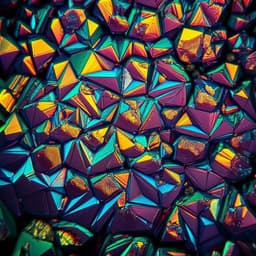
Physics
On-chip plasmonic spin-Hall nanograting for simultaneously detecting phase and polarization singularities
F. Feng, G. Si, et al.
Discover groundbreaking research by Fu Feng, Guangyuan Si, Changjun Min, Xiaocong Yuan, and Michael Somekh on an innovative on-chip plasmonic nanograting structure. This technology allows for the concurrent detection of polarization and phase singularities in cylindrical vortex vector beams, paving the way for advancements in integrated photonic circuits.
~3 min • Beginner • English
Introduction
Optical singularities are key elements in modern optics and have been widely researched. In particular, phase and polarization singularities have been manipulated in various applications, such as imaging and metrology, nonlinear optics4, optical tweezers5, sensing7, quantum information7, and optical communication7,8.
The phase singularity of an optical field was first theoretically and experimentally demonstrated in the 1970s9. Since then, the optical vortex (OV) has been the most widely used optical beam with a phase singularity. The unique properties of the OV, such as a spiral phase wavefront, orbital angular momentum (OAM), and donut-shaped intensity distribution, have been used for optical communication in both free space and optical fibres in both classical and quantum regimes to greatly enhance the information transmission ability6–8,10. Moreover, owing to the OAM generated by the rotating wave front, OVs can be used in optical tweezers to manipulate nanoparticles11. The unique spatial intensity distribution, especially in focusing, also has advantages in imaging and lithography12.
The cylindrical vector beam (CVB) is the most commonly used optical beam with a polarization singularity. Two typical CVBs are radially and azimuthally polarized beams in which the electric field oscillates along the radial and azimuthal directions, respectively13. Because of their polarization singularity and vector nature, such beams can be used, for example, to generate subwavelength focus14 and optical needles15. In addition to the solo phase or polarization singularity, an optical beam can have two singularities simultaneously. Such a beam is called a cylindrical vortex vector beam (CVVB)13, which provides a higher degree of freedom for modulation and manipulation in optical communication, optical trapping, and microscopy15–17.
Correspondence: Changjun Min (cjmin@szu.edu.cn) or Xiaocong Yuan (xcyuan@szu.edu.cn) or Michael Somekh (mike.somekh@szu.edu.cn)
¹Nanophotonics Research Center, Shenzhen Key Laboratory of Micro-Scale Optical Information Technology, Shenzhen University, Shenzhen 518060, China
²Melbourne Centre for Nanofabrication, Victorian Node of the Australian National Fabrication Facility, Clayton, VIC, Australia
³Full list of author information is available at the end of the article
The Author(s) 2020
Open Access This article is licensed under a Creative Commons Attribution 4.0 International License, which permits use, sharing, adaptation, distribution and reproduction in any medium or format, as long as you give appropriate credit to the original author(s) and the source, provide a link to the Creative Commons license, and indicate if changes were made. The images or other third party material in this article are included in the article’s Creative Commons license, unless indicated otherwise in a credit line to the material. If material is not included in the article’s Creative Commons license and your intended use is not permitted by statutory regulation or exceeds the permitted use, you will need to obtain permission directly from the copyright holder. To view a copy of this license, visit http://creativecommons.org/licenses/by/4.0/
To use the advantages of a CVVB, it is essential to have an easy and reliable way to detect both phase and polarization singularities simultaneously. It has been proven that a CVVB can be treated as a sum of a left-circularly polarized (LCP) and a right-circularly polarized (RCP) OV beam with different topological charges18. The Jones matrix of a CVVB can be expressed as
J_lm = e^{i(lφ + φ0)} [cos(mφ + φ0); sin(mφ + φ0)] = (1/2) e^{i(l−m)φ + φ0} [1; i] + (1/2) e^{i(l+m)φ + φ0} [1; −i] (1)
where φ is the azimuthal angle, φ0 is the initial phase angle, l is the topological charge value, and m is the polarization order. A CVVB with topological charge l and polarization singularity m can be expressed as an incoherent sum of an LCP OV beam with topological charge l+m and an RCP OV beam with topological charge l−m. In theory, both singularities can be detected simultaneously if one can detect the topological charge and photon spin at the same time. Several methods have been proposed to detect the topological charge of the OAM in recent years, including holography19,20, meta-surfaces21,22, optical transformation23-28, and photonic circuits29. However, these methods have drawbacks including the need to align the beam precisely with the structure, the need for complex detection processes, such as near-field microscopy, and the low diffraction efficiencies of some elements. These drawbacks strongly limit their applications in new optical systems with optical fibres or integrated on-chip devices.
In this paper, we propose and demonstrate an on-chip device that can simultaneously detect both phase and polarization singularities of a CVVB using a designed plasmonic spin-Hall nanograting. First, a double grating was designed on a metal surface such that input OV beams with different topological charges can be coupled to a surface plasmon polariton (SPP) wave propagating in different directions depending on the topological charge. Then, the SPP wave is coupled to the far field by two additional coupling gratings placed on the left and right sides to facilitate detection. As the topological charge of the incident OV beam increases, the excited SPP propagates to a higher angle on the metal surface and thus couples out to the far field at a different position relative to the coupling gratings. We can calculate the corresponding topological charge of the incident OV beam by measuring the propagation angle of the generated SPP. However, such a structure cannot detect the spin of the input beam. To solve this problem, a spin-Hall meta-slit has been integrated with the double grating to generate a chiral-response structure, which guides the generated SPP wave to the left or right side depending on the spin of the input beam. Altogether, we demonstrate that the structure generates an SPP wave that propagates to the four quadrants on a metal surface under LCP/RCP light with positive/negative topological charge illumination. As mentioned previously, both the topological charge value and the spin state can be determined from the propagation angle of the SPP wave. Thus, the structure is capable of fully discriminating the phase and polarization singularities of the input beam simultaneously.
Literature Review
Methodology
Design principle and modeling:
- A symmetry-breaking double grating is patterned on a metal (silver) surface with different periods for the upper and lower halves (A1 and A2) to enable unidirectional surface plasmon polariton (SPP) excitation that depends on the sign of the optical vortex (OV) topological charge l.
- K-vector matching for SPP excitation with a normally incident OAM beam follows: K_SPP = G + K_OAM, where G = 2π/A is the grating reciprocal vector and K_OAM = 2πl/r is the azimuthal in-plane wavevector component set by topological charge l and effective beam radius r (the incident beam fills the objective back aperture to define r).
- The SPP propagation angle θ relative to the grating axis satisfies θ = 2·arcsin(K_OAM / (2π/A)). Measuring θ yields |l| but not its sign.
Symmetry-breaking for sign discrimination:
- Implement a double grating with two distinct periods A1 (upper) and A2 (lower) such that for l = ±1 the vectors K_SPP, K_OAM, and G are collinear but with opposite allowed directions in the upper vs lower halves. This breaks left–right symmetry to produce unidirectional SPPs that reverse with the sign of l.
- Chosen periods from phase-matching: A1 = 550 nm and A2 = 660 nm. Under l = +1 the SPP propagates to the right; for l = −1 it propagates to the left.
Spin sensitivity via spin-Hall meta-slits:
- Each grating line is replaced by a spin-Hall meta-slit composed of a pair of nanoslits oriented at −45° and +45°, acting as dipolar sources with a relative phase delay Δφ = ±π/4 under circularly polarized illumination, launching SPPs preferentially right/left for LCP/RCP.
- Meta-slit geometry: slit length 250 nm, width 50 nm, depth 60 nm. Each pair has vertical displacement of 100 nm (within a total vertical spacing d = 200 nm) and lateral spacing D = λ_SPP/4.
- Material/operating wavelength: silver/air interface illuminated by a 633 nm laser. Effective SPP wavelength λ_SPP ≈ 610 nm (from λ_SPP = 2π/k0·sqrt(ε_air ε_Ag /(ε_air + ε_Ag))). Thus D ≈ 152.5 nm; vertical spacing d = 200 nm. Upper and lower meta-slit orientations are inverted so their chiral responses are opposite.
Output coupling and readout:
- Two output coupling gratings are placed symmetrically left and right at distance L from the excitation region to scatter SPPs to the far field at local spots. The displacement D′ of the spot from the X-axis is D′ = L·tan(θ). Measuring D′ determines θ and therefore l via the relation above.
Numerical simulations:
- Finite-difference time-domain (FDTD) simulations model SPP excitation and propagation under LCP/RCP OAM beams with l = ±1, confirming quadrant-dependent unidirectional launching and the increase of θ with |l|.
Fabrication and experimental setup:
- The spin-Hall nanograting and output gratings were fabricated by focused ion beam (FIB) lithography in a metal film per the parameters above. Output gratings were placed 40 μm from the central structure, with period approximately matching the SPP wavelength (reported as 620 nm for the fabricated sample’s output couplers).
- Optical microscopy was used to image the scattered SPPs from the output gratings under illumination by OAM beams with controlled circular polarization (LCP/RCP) and various l. The incident beam’s horizontal centerline was aligned to the grating centerline to fulfill the designed coupling conditions.
Key Findings
- The proposed on-chip plasmonic spin-Hall nanograting simultaneously discriminates the polarization (spin) and the phase singularity (topological charge sign and magnitude) of incident cylindrical vortex vector beams.
- Symmetry-breaking double grating (A1 = 550 nm, A2 = 660 nm) yields unidirectional SPP launching that flips direction with the sign of l.
- Integrating spin-Hall meta-slits (±45° nanoslit pairs; 250×50×60 nm; D = λ_SPP/4 ≈ 152.5 nm; d = 200 nm) provides chiral response: LCP and RCP guide SPPs to opposite lateral directions.
- Combined effect: incident beams map to SPP propagation in distinct quadrants, enabling simultaneous spin and sign discrimination. Mapping observed/validated:
• LCP with positive l → 1st quadrant
• RCP with negative l → 2nd quadrant
• LCP with negative l → 3rd quadrant
• RCP with positive l → 4th quadrant
- The SPP propagation angle θ increases monotonically with |l|, allowing quantitative determination of |l| from the far-field displacement D′ = L·tan(θ). Simulations and experiments (RCP, l = 1, 2, 3) confirm increasing θ and D′ with l.
- Experimental validation via optical microscopy images shows unidirectional coupling consistent with simulations and theory.
- Reported efficiency: overall SPP propagation and out-coupling efficiency is low (estimated <1%), comparable to other plasmonic devices.
- Practical discrimination of topological charge is feasible up to about |l| ≤ 6; beyond this, reduced coupling efficiency and reduced spot separation hinder reliable detection.
Discussion
The study addresses the challenge of simultaneously detecting phase and polarization singularities of structured light on an integrated platform. By combining a symmetry-broken grating that converts the azimuthal k-vector of an OAM beam into a directional SPP with spin-Hall meta-slits that impart chiral, spin-dependent launching, the device encodes both the sign and magnitude of the topological charge and the circular polarization state into the quadrant and angle of SPP propagation. This enables full discrimination of a CVVB’s two key degrees of freedom in a compact, on-chip architecture. The far-field readout through output gratings translates SPP direction and angle into easily measurable spot positions, avoiding complex near-field detection. The demonstrated agreement between FDTD simulations and experiments confirms the robustness of the k-vector matching design. This approach is relevant for integrated photonics where compact, alignment-tolerant, and multifunctional elements are needed for communications, sensing, and quantum information systems leveraging OAM and vectorial light.
Conclusion
The work introduces and demonstrates an on-chip plasmonic spin-Hall nanograting that simultaneously detects the polarization state and phase singularity (topological charge sign and magnitude) of cylindrical vortex vector beams. A double grating with asymmetric periods ensures sign-dependent unidirectional SPP launching, while integrated spin-Hall meta-slits provide spin-dependent chirality, mapping LCP/RCP and ±l to distinct SPP quadrants and angles. Experimental results validate the concept, and quantitative readout of l is achieved via far-field displacement from output gratings. The device is promising for compact integrated photonic circuits that exploit structured light. Future improvements could include increasing separation between excitation and output gratings to enhance angular/positional resolution, optimizing metaslit and grating geometries to raise coupling efficiency, and exploring lower-loss surface waves or materials to mitigate Ohmic losses.
Limitations
- Efficiency: Overall coupling and propagation efficiency is low (estimated <1%), limited by Ohmic losses in plasmonic propagation.
- Dynamic range: Reliable discrimination becomes difficult for high-order OAM (|l| > 6) due to decreasing coupling efficiency and reduced spot separation at the output.
- Alignment and beam parameters: Effective K_OAM depends on the beam radius; experiments require the beam to fill the objective back aperture and be centered on the grating to meet designed phase-matching conditions.
- Material constraints: Silver-based SPPs suffer loss; device performance depends on fabrication precision (FIB tolerances) and surface quality.
- Output grating design: The spatial resolution of D′ is limited by the separation L and out-coupler characteristics; insufficient L reduces discrimination between adjacent l values.
Related Publications
Explore these studies to deepen your understanding of the subject.







